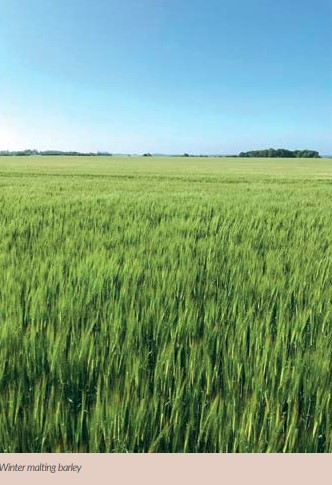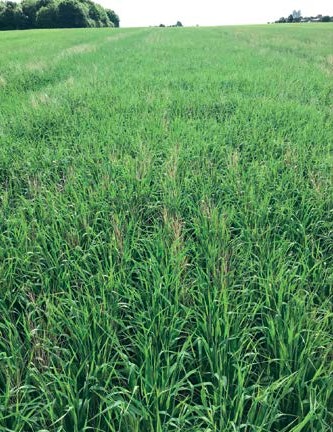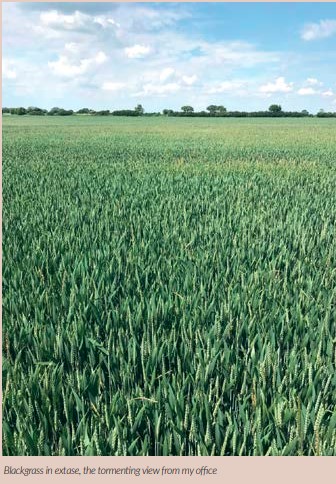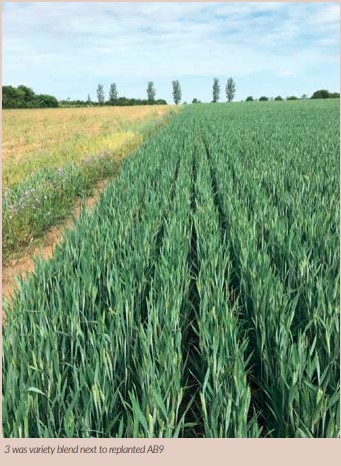
The mental weather continues on from the last time I wrote something for this magazine. Stuff looks pretty good. I thought I would do a candid evaluation of how crops are looking to start with.
Winter Wheat – pretty good on the whole, difficult drilling conditions and some poor headlands. We drilled a chunk very early. Blackgrass control is reasonable with the farm looking quite clean. There is a general smattering after OSR which is disappointing but not yield sapping, two fields are quite bad and will lose some yield in the worst patches. These areas also correlate to some drainage issues where they sat wet over the winter. Obviously one of these is directly outside my house and tormenting me on a daily basis. Crops are clean of disease, perhaps we overspent on fungicides this year. We are working hard to understand the relationship between nutrition and disease. We have been SAP testing with novacrop and doing the usual stuff like brix, ph etc. I do not have enough confidence in it and myself yet to do it wholesale but we are making in roads and will push harder next year. It is a fascinating subject and shows real promise agronomically.

Winter Malting Barley – Looks amazing, drilled early and very little blackgrass. I have been repeatedly told that barley cannot to be direct drilled as it likes loose soil. It is a great crop to point you towards compaction issues. Bearing in mind some of this land has not been move to any depth for 5 years the only issues we have found are a few wet areas suggesting we need to mole drain one 9ha field.

OSR – Good and bad. Good after early harvested wheat and barley, not good to average after spring barley. We actually took the decision to spray on 13ha last week, it was just not going to be worth it with weeds growing which would compromise the following crop. We have subsequently mole drained and will plant a cover crop into those 3 fields. Spend has been kept very low and prices are high so it should be a nicely profitable crop. I do hate it though and am considering dropping it again. Blackgrass always seems to creep back into it and it can be so fickle.
Spring cereals – Difficult start but now looking okay. Learning more and more how to deal with cover crops on this land so they do not become a hindrance to establishment. Loads of broadleaf weeds this year! It is vital we get these right as they are now such an important part of our system. I have heard of some fair yield drops in spring cereals where the cover crop has been managed wrong or contains cereal based components.

Thankfully due to the wealth of knowledge sharing online we have mostly been able to avoid these issues.
Looking Ahead
Driving around and talking to farmers from around the UK, it seems like this is the worst year for blackgrass in a long while. As said earlier we aren’t too bad but far from perfect. It really does reinforce the view that we are only just about keeping it in check even with more varied rotations and lower output crops. Years of continuous wheat or very tight rotations relying on chemical controls have certainly left many areas in a muddle. It shows to me the importance of having lower cost systems. We cannot grow as much output anymore, as the easy chemical options are simply not there. We have to grow lower output in order to survive agronomically, but many are still geared up for growing loads of wheat and rape. The overheads need to fit the output. I have used blackgrass as an example, as its so in your face and pertinent this time of year, but the same thinking counts for all manner of agronomic issues. The “Chasing the Red Queen” analogy comes to mind when thinking about all this.
With BPS going it brings the stark reality of what was fit for purpose ten years ago no longer is acceptable. Coupled with the traditional chemical toolkit shrinking or no longer working, rising machinery prices, environmental scrutiny around fertiliser and other farming practices, emerging carbon markets, ELMS and the increasingly odd weather. It seems to me that lower cost “regen” systems, focused on margin rather than simply yield are going to be vital. Saying that there is also no point in saving pennies to lose pounds and most importantly we need to grow good crops. When you start adding things up, for example mid tier cover crops, carbon selling, lower input costs (a bit of a slow burner but many are making good in roads) and a sizeable reduction in overhead costs it really starts to make high cost systems look very questionable. We can all grow the same crops for the same or very similar yield whilst putting much less capital at risk in the process, and get paid for providing tangible benefits as opposed to being given money simply for owning land as is the current subsidy.

There should be absolutely no reason we cannot achieve all these other benefits whilst still growing decent yielding crops and feeding people. So often in farming circles production and environment are talked about as two different things, whereas the reality is they can and should be in harmony. As we farm for other people it has been interesting discussing the future with them and the various land agents who are also involved. Thankfully most of them are fully on board with what we are doing. Discussing the loss of BPS, ELMS and carbon credits etc has proven very useful and it makes these relationships so much easier when you are on the same page.
I always say it in these articles, but I am so excited about the future of agriculture in this country.
Wishing everyone a successful and safe harvest!